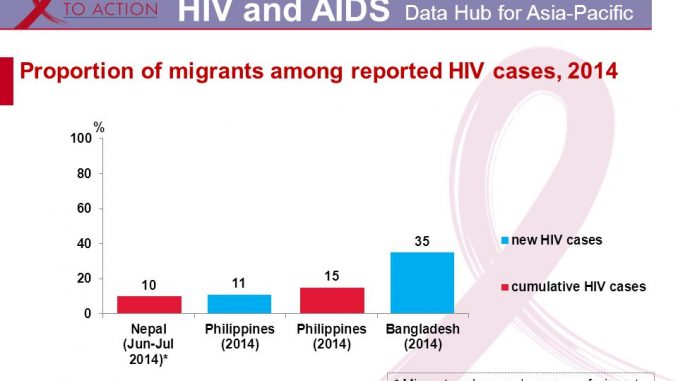
Table of Contents
Introduction to HIV and AIDS:
- HIV stands for Human Immunodeficiency virus.
- It is a retro virus that attacks the immune system. To be more precise, this virus reduces the CD4 cells of the body.
- HIV weakens the immune system of a person and makes them vulnerable to the other infection
- AIDS is the condition or the severe phase of the HIV infection when the individual’s immune system is totally disrupted.
- AIDS stands for Acquired Immune Deficiency Syndrome.
- HIV transfers from a person to person when the bodily fluids are shared during sexual intercourse, or through the sharing of the infected needles or such instruments.
- HIV also transfers from infected mother to the child through transplacental transformation
Current Global Status of HIV and AIDS:
- 9 million people globally were living with HIV in 2017 among whom 1.8 million are below 15 years
- 7 million people were accessing antiretroviral therapy in 2017.
- 8 million people became newly infected with HIV in 2017.
- 940 000 people died from AIDS-related illnesses in 2017. AIDS related death has decreased by 51% since 2004.
- Since 2000, new infected cases have been rapidly decreasing, globally.
- There is also decline in the numbers of AIDS related death
- HIV infections among the children has also been decreasing
Reasons for decreasing trend of HIV infected people:
-
Increasing coverage of Antiretroviral Therapy (ART):
- Number of patients receiving ART has increased globally.
-
Investment in prevention:
- Investment in prevention is the best and cheap method for prevention of the disease.
- In the past decade, massive prevention programs and campaigns have been carried out in a very large scale.
- Involvement of media, multi-sectoral approach too has helped in promoting the prevention.
- Behavioral change approach has contributed a lot for decreasing trend of HIV
- Increment in the capacity and commitment
- In the past few years, global political commitment and action has also increased towards the AIDS prevention.
- Governments and donor agencies have been spending lot of money in AIDS prevention, control and management
- Global action and support from bilateral and multi- lateral agencies.
-
Access to care:
- Anti-retro viral therapy is the other reason for the decrease in death due to HIV
- 7 million people have access to care.
- Global coverage of antiretroviral therapy reached 46% by the end of 2015.
- Countries most affected by HIV&AIDS rapidly increased the access to health care
Strategies to combat HIV among the migrant population:
Country of origin and destination both should adopt the measures to address HIV and AIDS among migrant population:
1. Strengthen prevention and testing programs for migrants
- Carry out awareness campaign
- HIV and AIDS screening or diagnostic test could be made compulsory
- Make the treatment cost effective and available
- HIV and AIDs control programs needs to be targeted to migrant workers and their spouses as well.
2. Promoting and implementing migrant-sensitive health policies, legal and social protection and interventions
- Ensure that national laws recognize labors, migrants and their right to health
- Make the health services accessible to such population and their families
- Awareness to encourage migrant population to seek services
- Discourage any kind of discrimination and stigmatization
3. Strengthen the evidence base on HIV and migrants
- More research needs to be done on the subject matter.
- Research about the present status, cost effectiveness of the interventions, etc
- Collection of data on the risk behavior of the migrant
- Enhancement of health monitoting system
Some Global examples of projects targeted to address HIV and AIDS among migrant population:
Germany:
- The FluG (Flucht and Gesundheit) project in Germany offers a range of HIV prevention interventions as part of a wider action to address the health issues of newly arrived migrants. The project cooperates with a range of organizations including e.g. the Red Cross and involves migrants as peer educators. This project too provides health services to refugee as well.
Norway:
- AKSEPT in Norway uses peers to provide psychosocial support for migrants living with HIV. AKSEPT majorly serves the migrants along with other ethnic minorities, people living with HIV and many more. AKSEPT is a center offering guidance and support to all who are affected by HIV. The major aim is to empower such people and improve quality of life.
Portugal:
- The Living with HIV/AIDS project in Portugal provides home care, treatment, psychosocial, rehabilitation and legal support for migrants living with HIV and their families, working with care providers from migrant communities and multidisciplinary teams.
References and for more information:
https://www.hiv.gov/hiv-basics/overview/about-hiv-and-aids/what-are-hiv-and-aids
https://www.webmd.com/hiv-aids/understanding-aids-hiv-basics#1
http://www.unaids.org/en/resources/fact-sheet
https://www.hiv.gov/hiv-basics/overview/data-and-trends/global-statistics
http://www.unaids.org/sites/default/files/media_asset/AIDS_by_the_numbers_2015_en.pdf
http://data.unaids.org/publications/irc-pub02/jc637-globalframew_en.pdf
http://www.who.int/hiv/mediacentre/news/global-aids-update-2016-news/en/
https://www.avert.org/global-hiv-and-aids-statistics
https://ecdc.europa.eu/sites/portal/files/documents/HIV%20and%20migrants.pdf
http://www.who.int/migrants/publications/SEARO-report.pdf
https://www.aidsactioneurope.org/en/organisation/aksept